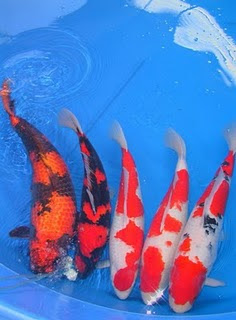 Oxygen is vital to all living organisms living in your pond. Seems simple enough to understand that fish need air yet, what if the oxygen level is too low? What increases oxygen concentration? Why is more better and what are the benefits? How can we test the oxygen level or content? How can we get oxygen towards the bottom of a deep pond? The following should help.
Oxygen is vital to all living organisms living in your pond. Seems simple enough to understand that fish need air yet, what if the oxygen level is too low? What increases oxygen concentration? Why is more better and what are the benefits? How can we test the oxygen level or content? How can we get oxygen towards the bottom of a deep pond? The following should help.Low oxygen concentrations can cause fish to be increasingly susceptible to disease and even die suddenly. The sad part is the large fish die first when the oxygen level is too low. Oxygen concentration decreases when; temperature increases especially above 80 �F, over stocking, heavy amounts of decaying matter exist in the pond or with either poor or no circulation of pond water.
Moving water helps mix air into the water and provides a means of natural gas exchange into the atmosphere. A stream, waterfall and jets can perform this very well. By moving the water surface of a pond with pond jets, the atmosphere and water contacting each other repeatedly will increase the oxygen content of the water. Some choose to add an air pump and air stone to increase oxygen concentration. The mixing takes place at the surface as the bubbles burst and with the movement of the surface water moving away from the rising air and water column.
 Colder water contains more oxygen than warm water. Some choose to turn off water features during winter months. This does two things. It saves on electricity and slows down the cooling of the pond. Some refer to this as "Turbo Cooling". The disadvantage to turning off the pump during winter's coldest months is that the biological filter will be slow in starting up again as temperatures begin to rise.
Colder water contains more oxygen than warm water. Some choose to turn off water features during winter months. This does two things. It saves on electricity and slows down the cooling of the pond. Some refer to this as "Turbo Cooling". The disadvantage to turning off the pump during winter's coldest months is that the biological filter will be slow in starting up again as temperatures begin to rise.By increasing the "oxygen" levels in the pond water, it will promote an overall healthier pond. One important area that higher levels of oxygen saturation help is in better promotion of good biological bacteria known as aerobic bacteria. Aerobic bacteria are the good bacteria in our pond that like oxygen. They grow and eat dead decaying plants, algae and pond muck up to 30 times faster than anaerobic bacteria (an-aerobic). Anaerobic bacteria live and grow in the absence of oxygen. Maintaining a constant supply of oxygen greatly improves the ability for the aerobic bacteria to thrive and keep your pond bottom cleaner, the water clearer and fish healthier.
There is a point of oxygen saturation. To find your level of dissolved oxygen or oxygen concentration, you could use a test kit. Or even better are the electronic type testers called "Dissolved Oxygen Meter". The meters are not cheap and start around $150 and up. While an O2 test kit can cost around $12. The advantage to the Dissolved Oxygen meters is that the probe can be lowered to test the oxygen level at different levels for those with deeper ponds.
Ponds that are designed with bottom drains permit better oxygen disbursement towards the bottom because water usually enters the pond's top surface and is drawn out from the bottom drain. This method recirculates the pond's total water column better than those that do not draw the water from the bottom. More oxygen content close to the bottom promotes the good bacteria which consumes waste that settles on the bottom. Ponds that are in the colder climates like the United Kingdom, sometimes will draw the water from the mid-pond level permitting the bottom half of the pond water to remain warmer for the fish.
Note: Decaying plants in a very low oxygen level pond can create a toxic dissolved gas known as Hydrogen Sulfide.




No comments:
Post a Comment